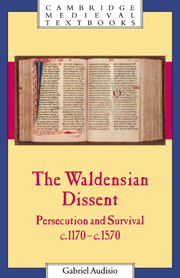Book contents
- Frontmatter
- Contents
- List of maps
- Preface
- Acknowledgements
- Introduction
- 1 1170 – 1215: decisive and purposive origins
- 2 The thirteenth century: the need to adapt
- 3 The fourteenth century: the challenge of believing differently
- 4 The fifteenth century: the risks of longevity
- 5 The constraints of a life in hiding
- 6 The need to organise
- 7 A culture of their own: the written and the spoken word
- 8 The sixteenth century: the end as a way forward?
- 9 Epilogue: the Waldensian Church
- Conclusion
- Bibilography
- Index
- Cambridge Medieval Textbooks
8 - The sixteenth century: the end as a way forward?
Published online by Cambridge University Press: 05 June 2012
- Frontmatter
- Contents
- List of maps
- Preface
- Acknowledgements
- Introduction
- 1 1170 – 1215: decisive and purposive origins
- 2 The thirteenth century: the need to adapt
- 3 The fourteenth century: the challenge of believing differently
- 4 The fifteenth century: the risks of longevity
- 5 The constraints of a life in hiding
- 6 The need to organise
- 7 A culture of their own: the written and the spoken word
- 8 The sixteenth century: the end as a way forward?
- 9 Epilogue: the Waldensian Church
- Conclusion
- Bibilography
- Index
- Cambridge Medieval Textbooks
Summary
Who could have imagined the repercussions that were to follow Luther's spark of inspiration in Wittenberg which became a protest and finally a movement of social and religious disobedience between 1517 and 1520? Neither the clerical class as a whole, nor the majority of political leaders took the trouble-making monk particularly seriously. When on 15 June 1520 pope Leo X issued the bull Exsurge Domine excommunicating Martin Luther, he believed he had settled the affair definitively. The Church, after all, had centuries of experience of dealing with schisms and heresy; this was the manner in which it traditionally eliminated its dissenters and enemies. Who had vied successfully with the Church? The immense and powerful normalising forces of ecclesiastical power, reinforced by the secular arm, had in time broken down all resistance and subdued even the most stalwart opponents. How could an Austin friar from Saxony possibly trouble Rome, even if he was a university professor? Even when, in answer to the pontiff's sentence, he burnt the bull of excommunication on a public square on 10 December 1520 with widespread local support - an act nevertheless of rare audacity - showing that he persisted in his schismatic position, the odds were still heavily against the subversive monk.
Even today, the causes of the Reformation are widely debated even if both theoretical and formal ecumenism ensure modern debates are far less rumbustious than they were before. The conditions of its success, however, are well established.
- Type
- Chapter
- Information
- The Waldensian DissentPersecution and Survival, c.1170–c.1570, pp. 161 - 188Publisher: Cambridge University PressPrint publication year: 1999

